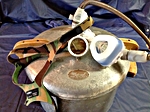There was at least one other post in this forum on building a manometer. This was one has a couple of features to make it easier to read, and measure the pressure while you use the system, rather than just check the static pressure of your machine when there is no flow of air.
All you need is piece of clear flexible tube, similar to the one used in home aquariums, a centimeter graduated ruler, and plastic water pipe 1/2 tee, two small pieces of 1/2 pipe a cork or plastic equivalent from a very good quality wine bottle that will fit snugly into the tee. If the ruler has hole at one end, it is easier to hand this vertically on the wall, but you can probably tape it with masking tape to the wall. The two photos below shows the completed manometer, and the connection/insertion into the cpap tube. BTW, the slightly colored area is a little bit of water colored with food coloring so it is clearly visible.
Below, I am using a thinner tube than the aquarium type, since I happen to have that. If you use such thinner tube, it is a good idea to add a very small drop of liquid soap as well to the colored water, so that surface tension induced errors are minimized.
The tube is attached to the ruler with rubber bands or other things, such that it is not constricted at the point of support. A hole just small enough to snugly fit the tube is made (this hole should go clear thru the cork), the tube inserted into the cork, and the cork is inserted into the tee. You add the colored water into the tube. Now see the important Notes below, follow them carefully, if you wish to make your meter accurate.


Note 1. Pour just enough of the colored water, so that when held vertically, the two vertical portions of the tube will be filled exactly to the 10 cm mark on the scale. This simple trick makes the pressure reading much easier. When there is positive pressure in the cpap tube, water in the left open side of the tube will go up, and the one in the right side will go down. Suppose the left side level under some pressure you want to measure stands at 14.5 cm. Then the pressure you are reading is (14.5-10) * 2 = 9cm.
Note 2. Make sure the left arm of the tube is above the 20cm mark on the ruler, so that at the highest cpap pressure of 20cm, the water will not be pushed out of the meter. Adjust this level longer if your machine goes above 20cm.
Note 3. Use clean, distilled water, and the measurement will be more accurate, and the water can stay in the tube for a long time without something growing in it
Note 4. The ruler can be at any level, higher or lower than the cpap end, and you can use as long a clear tubing as you want without affecting accuracy.
Note 5. I have added a snugly fitting self threading screw to the top of the left open end (sorry not very clear). This is not essential, but this would minimize accidental spilling of the water, if the tube with the water is somewhat tilted. If you use this, make sure the left hole is not closed off completely; that is why I use the self threading screw which has cut notch at the beginning; only just enough inserted to leave a hole. You can check if there is sufficient opening here by tilting the ruler left or right from the vertical. The level in the two sides should change and when you bring back to the vertical it should get back to the original equal height fairly quickly.
----------
Edited 2008.9.24
Note 6. When you inserted the cork into the tee, inserted it enough so that a small portion of the end of the cork can be seen when viewed through the other two holes of the tee. This is important for accuracy. The aim is to make the cross section of the tube where the cork (with the vinyl tube just jutting out) is the same as the cross section of your cpap tube. If it is blocked off too much or opened out too much by the cork not going up to there, venturi effects may cause some small pressure error to be introduced. Do not be too concerned about this, if you do not quite follow this.
-----------
Now, how to measure how much drop is there when using the cpap at a certain pressure and flow, without wearing the mask: See the photo below.

I am using the Swift LT nasal pillow. The green ear plugs will simulate 0 unintended, but normal flow through the out port at that pressure. If you use another type of mask, you need to figure out to seal the normal interface area of the mask, while keep the out port clear.
To measure the drop in a 2' length of cpap tube at a pressure of say 10cm, you set the machine for 10cm. Insert the manometer tee to one end of the 2' tube. Run the machine, read the pressure. It would be very close to 10cm. Now stop, move the tee to the other end and measure again. The difference between the above reading is the pressure drop in the 2' tube under the flow the outport at that pressure.
Suppose including your unwanted leak the flow is twice that at that pressure. Then the drop in the tube under the leak condition will be twice that of you measured. You would find this pressure drop very very small for a 2' tube length.
To measure the drop through a bacteria filter, you do a similar measurement with the tee inserted close to the filter on the machine end, and then again close to the filter at the mask end. Find the difference.

















